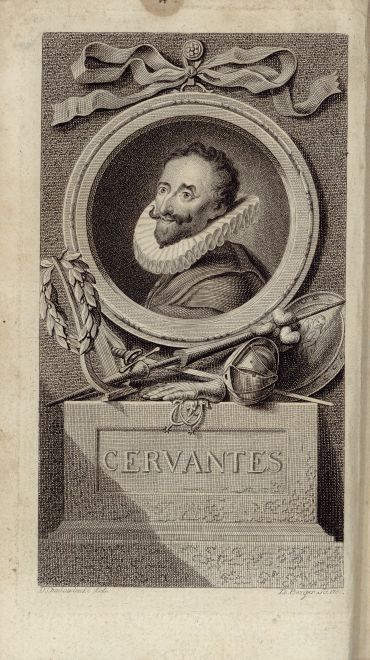
click to enlarge
Based on William Kent's design (London: Tonson, 1738), but now in a forced three quarters.
At the bottom, usual iconographical elements: lire and Apollo laurel wreath (Cervantes as a poet); helmet, sword, lance, armor glove, spurs and shield decorated with a "sad countenance" (Cervantes as a soldier and as "Don Quixote" author).
Drawing and engraving are of excellent quality (see detailed shading in Cervantes' face and in background).
Daniel-Nicolas Chodowiecki (Dantzig, 1726 – Berlin, 1801): Painter, engraver, illustrator and miniaturist. Born in Poland, in 1743 he arrived to Berlin. He was instructed in art by Haid and B. Rode, although Chodowiecki has been mainly considered a self-taught person. He succeeded as an illustrator for the “Almanac” of the Academy of Berlin; he designed and engraved plates with scenes from Jesus Christ’s life, Cervantes’ “Don Quixote” (1771) and others. In 1764, he became a member of the Academy of Berlin and a professor. As a painter, he was less successful. He painted great history compositions and genre scenes following Greuze and Pater’s style. His best works are his engravings (circa 2.896); illustrations for Ariosto’s “Orlando Furioso” (1772), Goethe’s “Werther” (1776), Shakespeare’s “Hamlet” (1778), “Macbeth” (1784), “Henry IV” (1785), “The Merry Wives of Windsor” (1786), “Coriolanus” (1786) and “The Tempest” (1787), works of Voltaire, Lessing, La Sage, Schiller, Rousseau, Lavater and others. The plates for Lavater’s “Physiognomic Fragments” (1775) took Chodowiechi 15 years (Benezit III, 9-10; Lenaghan 2003, 241-242).
Daniel Berger (Berlin, 1744 - ?, 1824): Designer, burin engraver and acquafortist. He was son and disciple of the engraver Fried-Gott. Berger. Berger was instructed in design by La Sueur at the Academy of Berlin and, when he was 20 years old, he entered G.-F. Schmidt’s atelier. Between 1786 and 1797, he exposed at the Academy of Berlin and, in 1778, he became a member of the Academy and, then, a professor (Benezit I, 652).